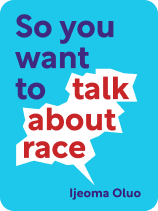

This article is an excerpt from the Shortform book guide to "So You Want to Talk About Race" by Ijeoma Oluo. Shortform has the world's best summaries and analyses of books you should be reading.
Like this article? Sign up for a free trial here .
How often do you find yourself discussing issues of race or racism? What is your comfort level in having conversations about race?
Race is a sensitive and contentious topic to talk about. However, talking about race is the critical first step in dismantling the structures and eradicating the practices that perpetuate racism.
Here are some things to keep in mind when having conversations about race.
Recognizing Conversations About Race
Most conversations about race are caught up in arguments about whether or not race is actually the issue. People might ask, “but isn’t it about class, not race?” or defend someone with “But he didn’t mean any harm!”
So let’s look at this more closely.
Here are three criteria to help you decide whether or not a conversation is about race.
Remember that just because a conversation is about race, that doesn’t mean it’s only about race. There might be many contributing factors. But if any of these criteria are met, race is one of them.
Race is relevant if:
1. A person of color says it’s about race.
- This may seem subjective. That’s the point. Through the process of having these conversations, you’re learning to listen to and value the opinions of people of color. People of color are experts in being people of color. If you’re white, you’re not an expert. Listen to the experts.
- The racial identity of the person of color is part of them and part of any situation they’re telling you about. That means that race is playing a role, even if it doesn’t seem to you like the main issue.
2. It affects people of color differentially or disproportionately.
- Some people ask: How can poverty be about race when there are lots of poor white people too? And what about the black billionaires?
- The point is not that something only affects people of color—it’s that its impact on them is greater than it would be if there were true racial parity. The fact that you can think of a black musician who swept an awards night or a Native American artist who’s achieved widespread recognition doesn’t mean it’s the rule. Do you need to come up with the names of white billionaires or musicians to prove that white people are doing well?
- For example, poverty affects all races. But people in Appalachia are not poor for the same reasons that people in Chicago are poor. The contributing factors are different, so the solutions need to be different. One person’s battle with brain cancer doesn’t cancel out another person’s battle with breast cancer. They’re two equally real diseases and need two real, targeted solutions.
3. It’s part of a pattern that affects people of color differentially or disproportionately.
- Racism is systemic. It takes many forms, from the subtlest to the most blatant. The fact that there are extreme forms of racism doesn’t make the subtler forms any less serious or any less racist.
- Here’s an analogy. You’re walking down the street. Every few minutes, a passer-by punches you in the arm. You can’t predict who or where the next punch will come from. After a while, you’re exhausted from trying to predict who will punch you next. Eventually, someone passes you, deep in conversation with a friend, gesturing excitedly and not paying attention to their surroundings. One of their wild gestures flies out and hits you in the arm. You scream, tired of defending yourself against all this unpredictable violence.
- It doesn’t matter whether or not the last punch was unintentional. Even if there were no bad intentions, the punch was part of a long history of violence you’ve been defending yourself against ever since you can remember. And this person has learned that it’s okay to gesture recklessly on the street without thinking about the consequences.
This is why demanding that a person of color “prove” the bad intentions of the last person who punched them misses the point. We need to be looking at the overall pattern of punches in the arm, the lack of self-reflection in the people who perpetuate this pattern unknowingly, and the scars on the arms of people who are constantly getting hit. Instead of arguing about the last person’s intentions, we need to be listening to the people who carry these scars and putting measures in place to protect them from getting hit again.
Yes, following these three criteria means that the threshold is low. And it should be. We need to be as inclusive as possible if we’re going to step back and understand the system as a whole.
Now, with the foundations clear and an understanding of the types of higher-level connections you need to look for, let’s look at how to have the conversation. Here are the practical nuts and bolts of how to go about having considerate and productive conversations about race.
Before the Conversation
Before the conversation starts, do your homework. Learn some facts about the area you’ll be talking about.
- If you’re a white person in conversation with a person of color, don’t rely on them to explain things you could easily find out for yourself. The other person is not your human Google. This especially applies if it’s an online conversation and you have easy access to a search engine.
- If you’re a person of color, doing some research before a conversation can help, especially if you’ll be talking about a tricky topic that you’re not intimately familiar with. Consider looking for some statistics to support your points.
Check your privilege (Chapter 2). Being aware of your privilege in the area you’re going to talk about will help you avoid ignorant statements and microaggressions.
Seek out different perspectives on the issue. Keep intersectionality in mind. If you’ve already talked to an Asian American man, seek out someone with a different background.
Check that the person wants to talk. Conversations about race are exhausting for people of color, so do everything you can to make the other person feel comfortable. If the other person doesn’t want to talk, or doesn’t want to talk right now, respect that.
During the Conversation
1. Clarify and share your intentions.
- Figure out the following: Why does fighting racism matter to you? (Or are you in the conversation just to prove you’re not one of the bad guys?) And why are you having this particular conversation?
- State your intentions clearly and allow your conversation partner to decide whether they want to proceed. Don’t force anyone to have a conversation they don’t want to have, no matter how important it feels. Remember how much pain and fatigue is embedded into these issues for people of color, and respect the decision of someone who doesn’t want to engage. If they choose to continue, fully appreciate the emotional and mental labor they’re volunteering.
- Throughout the conversation, bring your intentions to mind frequently. Are you behaving like you’re trying to win an argument, or like you’re genuinely trying to learn and do better?
- Remember that everyone in the conversation is taking a risk, not just you. The other person is nervous too. If it feels too comfortable, you’re probably having the wrong conversation.
2. Keep your priorities straight.
- If your aim is to understand your conversation partner’s experience of racism better, or to figure out what you can do to help, don’t lose sight of that.
- If something makes you feel defensive, remember that defending yourself isn’t the priority. Remember your intention.
- Self-monitor. If you feel yourself start to become defensive, stop and reflect. Why is this feeling arising? Is your ego or some part of your identity being threatened? Don’t let this feeling shift your priorities.
3. Listen more than you talk.
- Don’t put any conditions on your listening. Don’t force the other person to make something more palatable just so you’ll be willing to listen. Don’t tone police. The delivery style isn’t the point—the content is. So if a person of color is talking about their experiences this is an act of generosity, no matter how they’re doing it.
- If you’re a white person, notice how much you’re talking about yourself. If you hear yourself using “I” and “me” a lot, consider whether you might be challenging or overriding the other person’s experience.
- Pause frequently.
- Ask questions.
4. Be willing to feel uncomfortable.
- Listening to someone talk about their pain is painful. Don’t shy away. If you refuse to feel this pain, you’re forcing people of color to suffer it alone.
- If you’re doing the conversation right, it’ll make you feel upset. It may make you feel ashamed, guilty, angry, and shocked. Stay with these feelings and see where they lead you.
5. Talk to people of your own race too.
- If you’re white, talk about race in places where there are no people of color to speak for themselves. Bring these conversations into corners of your life where people of color can’t yet reach: within your family or in an all-white corporate boardroom.
- If you’re a person of color, talking to other people of color may help you to feel less alone in your experiences. It can help you to resist large-scale cultural gaslighting and remember that you’re not going insane, that your experiences are real. Compassionately bring to light your own internalized racism and the patterns of thinking and behavior that have made you unwittingly complicit in the system.
6. Don’t substitute racism for other prejudices.
- It’s not helpful to make prejudicial remarks about other groups. You can’t fight racism with sexist, homophobic, or otherwise bigoted ideas.
- Consider intersectionality. What perspectives might be invisible or oppressed here? What can you do to include them? If you need to explain intersectionality, it can help to give concrete examples.
7. Do what’s right, not what feels good.
- The purpose of these conversations is not to prove you’re a good person or that you’re not racist.
- Seek to find truth, not to be right.
What to Do if You Make a Mistake
If you’re having a lot of these conversations, it’s almost certain that eventually you’ll make a mistake.
If things really start to go pear-shaped, here’s what to do:
1. Apologize.
- If you understand what you did wrong, apologize sincerely.
- Even if the conversation was months ago, consider contacting the person to apologize. Better late than never.
2. Decenter your own feelings and intentions.
- Your intentions aren’t as important as your actions. Even if you had good intentions while screwing up, you still screwed up. Don’t try to get credit for having good intentions.
- When you remember the conversation later, remember what the purpose of the conversation was and what went wrong. Don’t file it away as “that time you tried really hard and the other person got angry anyway.”
3. Know when to leave it alone.
- You may feel you need some kind of resolution. Don’t push it. Take a break, think about what went wrong, and try again later.
4. Don’t castigate yourself for all eternity.
- If you did something that hurt someone, feeling bad is an appropriate response. But remember that this happens a lot, and it has more to do with needing to work on your communication skills than being a horrible person. Reflect, repair the damage if possible, and then drop the guilt and try again.
5. Keep trying.
- Failure doesn’t feel good. But for real change to happen, we need to keep having these conversations. Your failed conversations are better than your silence, because your silence is your complicity.
- These conversations are upsetting because the issues themselves are upsetting, not because we’re talking about them. The more we talk about them, the more we can do, and the less upsetting the reality will become.
Beyond the Conversation
Words are powerful. But they’re not everything. Having roductive conversations about race is a good start, but it’s just a start. Conversations lead to better understanding, but understanding without action is useless.
It’s easy to get hooked on the good feeling that comes with having successful conversations about race. But don’t get trapped in a feel-good cycle of saying the right things and doing nothing. It’s what we do after we have the conversations that matters. Instead of just talking about the White Supremacist fabric that’s suffocating people of color, poke some holes in it.
There are many ways you can put your new understandings into action in the political, educational, economic, workplace, and personal spheres. Pick whichever of these suggestions resonate best with you.
Political Actions
Vote. And not just in big elections: Vote on school boards, local elections, and so on. Local politics is often where the real change happens.
- Bother politicians before elections. Ask to see their policies on racial equality.
- Vote for candidates of color.
- Support racially inclusive and just policy platforms.
- Become involved in the campaigns of candidates of color.
Vocally support increasing the minimum wage. Proportionately more people of color work in minimum-wage jobs, so increasing the minimum wage will benefit more people of color.
Support affirmative action. Ever since the 1960s, affirmative action has aimed to increase the representation of marginalized groups in higher education and the federal workforce. The people who criticize affirmative action as “unfair” simply don’t know the facts. There have never been any quotas, and the goal representation percentages are often far below actual parity. For example, a Supreme Court decision in 1980 upheld the reservation of ten percent of funds for minority business, when the actual minority population was 17 percent. Affirmative action targets exist to redress a systemic opportunity gap. They’re not back doors or easy ways to get hired.
Approach mayors and local governments about police reform. Ask about policies regarding officer training, body cams, and complaints procedures. Demand reform wherever necessary. Keep applying pressure.
Insist on justice for police shootings. District prosecutors care about their jobs. If they risk losing their jobs because of publicity around their poor handling of police shootings, they’re more likely to follow due process.
Economic Actions
Harness the power of your wallet. Remember that economic inequalities are at the core of the White Supremacist system and do what you can to offset this.
Wherever possible, support businesses that are run by people of color. Boycott businesses that take advantage of people of color—steer clear of banks that employ racist lending practices and avoid businesses that rely on low-wage labor from people of color.
Donate to grassroots organizations that are working for change.
Offer compensation when you book a speaker of color. If you are trying to raise racial awareness in your workplace or community and want someone to come in and speak, don’t assume they’ll volunteer their time. Remember that we’re fighting against the economic exploitation of people of color, not participating in it.
Educational Actions
Engage with schools. Ask about the opportunity gap in your school district. Find out about the history curriculum. Are there any curricula and textbooks that erase people of color or teach a whitewashed version of history?
Contact teachers and educational leaders to tell them that racial issues are a priority.
If you’re at college, will soon be applying for college, or have a child in either of those situations, contact colleges to find out their policies and track record on diversity and representation.
Workplace Actions
Become active in your unions. A racially aware union can do a lot for people of color. If you speak up enough in your union over time, people will eventually start listening.
Call out tokenism. If management tries to implement perfunctory, superficial measures that look good but don’t run deep, let them know. In one of Oluo’s workplaces, for example, they conducted an employee satisfaction survey. One of the questions was about whether people of color felt they had equal opportunity with their colleagues. The results were clearly negative. But in the meeting in which they went over the survey, the director came to that slide, saw the results, and declared that people probably hadn’t understood the question before moving on to the next slide. Do all you can to prevent this from happening in your workplace.
Personal Actions
Diversify the art and music you engage with. Mainstream television, film, music, and literature is white by default. Seek out work by people of color, films in which the majority of actors are not white, and books by people of diverse backgrounds.
Watching films and reading books is a great way to listen to people of color without demanding personalized emotional labor.

———End of Preview———
Like what you just read? Read the rest of the world's best book summary and analysis of Ijeoma Oluo's "So You Want to Talk About Race" at Shortform .
Here's what you'll find in our full So You Want to Talk About Race summary :
- How to have an intelligent, empathetic conversation about race
- Why people are afraid to talk about race
- Where racism came from and what fuels it






